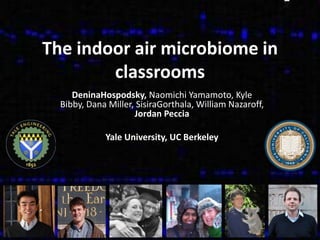
Peccia qiime vamps_workshop
- 1. The indoor air microbiome in classrooms DeninaHospodsky, Naomichi Yamamoto, Kyle Bibby, Dana Miller, SisiraGorthala, William Nazaroff, Jordan Peccia Yale University, UC Berkeley
- 2. Background How does the human occupant shape the indoor air microbiome? Classrooms Defined times of occupancy and vacancy Constant numbers of occupants Public places Children, a susceptible population, spend considerable amount of time in classrooms
- 3. Goals: Toidentifysources and calculate emission rates of indoor (bio)aerosols Objectives: To combine biomolecular techniques and particle modeling to assess the influence of the human occupant on shaping the indoor air microbiome To describe and model these two processes for biological and total particles To identify sources of bacteria and fungi in indoor air using phylogentic information Understand how building design and operation influences the indoor air microbiome shedding resuspension resuspension
- 4. Eleven sampling sites- classrooms, 3-4 days of continuous occupied and unoccupied sampling each Arhus Berlin Lyngby New Haven Lanzhou 1 Salinas Lanzhou 2
- 5. Study design Floor dust as well as indoor and outdoor air collection during times of occupancy and vacancy using multistage Andersen cascade impactor in eleven classrooms Quantitative data from qPCR for all samples Bacterial and fungal emission rate calculations Fungal ITS region from (almost) all air and dust samples Bacterial 16S region for floor dust and occupied air samples from eleven sampling sites
- 6. OccIn Occ out UO in UO out Floor Floor Floor Floor Location (Air) (Air) (Air) (Air) 1 2 3 4 Salinas New Haven 1 New Haven 2 New Haven 3 Arhus Berlin Copenhagen Lanzhou 1 summer Lanzhou 2 winter Lanzhou 1 summer Lanzhou 2 winter Bacteria 16S Fungi ITS only Bacteria 16S only No sample and Fungi ITS
- 7. Study design “metadata” Air temperature (minute) Humidity of air (minute) Particle mass and particle number concentration (all time averaged and per minute) Bacterial and fungal number concentrations in air and on dust (all time averaged) # of occupants and their activity rate (minute and time averaged per day) CO2 concentration and air exchange rate (minute and time averaged per day) Particle, bacterial, and fungal emission rate (all time averaged) Time scale 1min 1hour 1day 2days 3days 4days
- 8. Data and metadata sharing Previous sequencing data is available on MG RAST (and via MG RAST on MoBeDac) metadata documentedin SI or text of publications. New sequencing data will be submitted to Qiime DB and MG RAST including metadata No human subjects restrictions
- 9. Sequence data analysis Study needs: Easy access to sequence data from other groups Toolsets that allow graphical and analytical comparison of samples from our and other groups Costello et al, Science 2009 Lauber et al, AEM 2009
- 10. What do you hope to get out of the QIIME/VAMPS workshop? 1. Data deposition Clear guidelines about where to deposit sequencing data when publication date is nearing (MoBeDac? QIIME DB? MG RAST?) Convenient data deposition with and without “metadata” templates 2. Share sequence data with others Easy access to published sequencing data of other groups, especially within Sloan Access to raw data and processed data Clear communication on how raw sequence data was processed 3. Effective data pooling when sequence regions do not overlap Alignment tools for 16S and ITS region Enhanced tools for ITS sequences
- 11. Thank you!
Editor's Notes
- Slight change in title. We are not working on microbes and fungi in the indoor environment, instead the working title for today is THE INDOOR AIR MICROBIOME IN CLASSROOMS
- ~200 air and dust libraries for fungi~120 air and dust libraries for bacteria
- What to do with the dataHow to get access to other pplssequencesHow to use alignment tools for ITS and 16STools for ITS beta diversity
